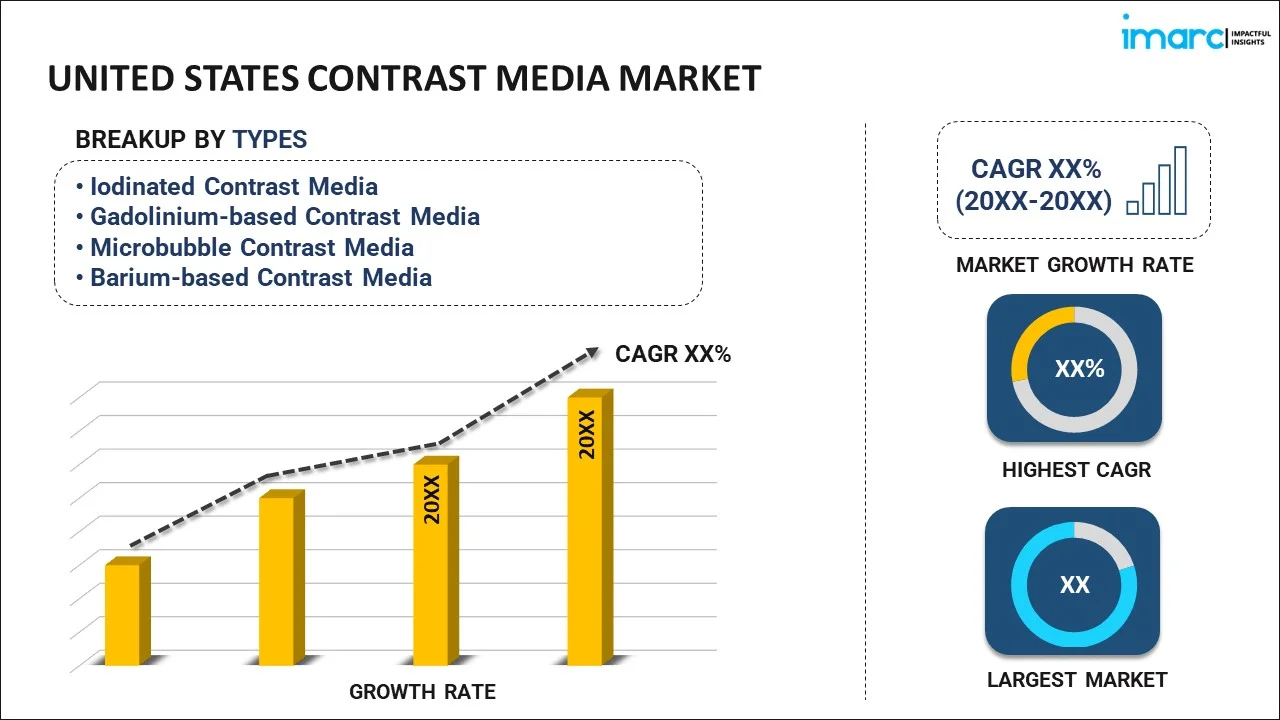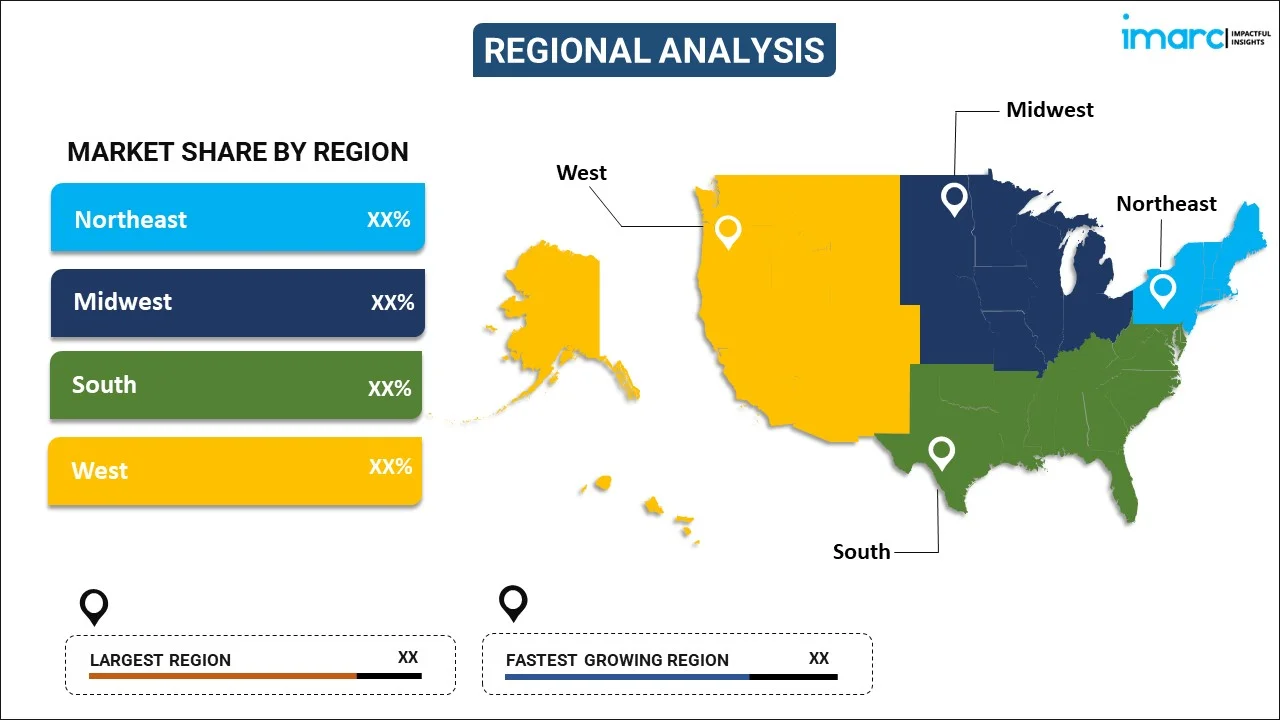
United States Contrast Media Market Report by Type (Iodinated Contrast Media, Gadolinium-based Contrast Media, Microbubble Contrast Media, Barium-based Contrast Media), Modality (X-ray/Computed Tomography (CT), Magnetic Resonance Imaging (MRI), Ultrasound), Application (Radiology, Interventional Radiology, Interventional Cardiology), Route of Administration (Intravenous/Intrarterial, Oral Route, Rectal Route, and Others), End User (Hospital, Clinics and Ambulatory Surgery Centers, Diagnostic Imaging Centers), and Region 2025-2033
Market Overview:
United States contrast media market size reached USD 1.2 Billion in 2024. Looking forward, IMARC Group expects the market to reach USD 1.8 Billion by 2033, exhibiting a growth rate (CAGR) of 3.9% during 2025-2033. The increasing prevalence of chronic diseases, aging population, emphasis on early detection, advancements in medical technology, collaborative research efforts, supportive regulatory environment, rising awareness, and expanding healthcare infrastructure represent some of the key factors driving the market.
|
Report Attribute
|
Key Statistics
|
|---|---|
|
Base Year
|
2024 |
|
Forecast Years
|
2025-2033
|
|
Historical Years
|
2019-2024
|
| Market Size in 2024 | USD 1.2 Billion |
| Market Forecast in 2033 | USD 1.8 Billion |
| Market Growth Rate (2025-2033) | 3.9% |
United States Contrast Media Analysis:
- Major Drivers: The older population in need of advanced diagnostic imaging fuels the United States contrast media market share. Growing prevalence of chronic diseases calls for sophisticated contrast-enhanced applications. Enhanced focus on earlier detection encourages contrast agent use. Favorable regulatory environment fosters market growth and product development.
- Key Market Trends: Increasing use of minimally invasive procedures drives United States Contrast Media Market Demand. Advancements in imaging technology are driving market growth. Multimodal imaging techniques broaden contrast agent applications. Increased outpatient imaging services provide new market opportunities for improved diagnostic capabilities.
- Market Challenges: Safety risks of adverse reactions from contrast agents raise safety issues. High development expenses of products restrict market access for new entrants. Strict regulatory approval procedures retard launches of products. Reimbursement limitations impact patient affordability and market access.
- Market Opportunities: New contrast agent formulations hold tremendous growth opportunities. Integration with artificial intelligence provides improved imaging functionalities. Personalized medicine strategies lead to targeted contrast solutions. Collaboration among pharmaceutical firms and research organizations fuels innovation and market growth.
Contrast media, also known as contrast agents or contrast dyes, are substances used in medical imaging procedures to enhance the visibility of internal structures or fluids in the body. It is typically administered intravenously, orally, or directly into specific body cavities. This solution contains elements that alter the way X-rays, computed tomography (CT) scans, magnetic resonance imaging (MRI), or other imaging modalities interact with bodily tissues. Some of the standard contrast media used for X-ray-based imaging include iodine and barium, while gadolinium is employed in MRI contrast imaging. These substances highlight blood vessels, organs, or specific tissues, enabling healthcare professionals to obtain clearer and more detailed images for accurate diagnosis and treatment planning. The use of contrast media is particularly valuable in identifying abnormalities, such as tumors, vascular irregularities, or organ malfunctions, that may be otherwise challenging to discern on standard images. The judicious application of contrast media significantly improves the diagnostic efficacy of medical imaging, contributing to better patient outcomes in various clinical scenarios.
United States Contrast Media Market Trends:
Advanced Gadolinium-Based Contrast Agent Development
The creation of next-generation gadolinium-based contrast agents is a key trend in United States contrast media market growth. Pharmaceutical firms are heavily investing in the formulation of macrocyclic gadolinium compounds with improved safety profiles and reduced gadolinium retention. The innovation targets the achievement of better image quality at the lowest possible adverse effects. The trend is stimulated by regulatory demands for safer contrast media and increasing physician awareness of gadolinium deposition issues. Firms are coming up with agents that have enhanced pharmacokinetic characteristics, allowing for reduced dosing needs at the same level of diagnostic effectiveness. This technology will gain a great portion of the market as patient safety becomes paramount for healthcare professionals. The trend also includes the creation of organ-specific contrast agents that offer target-directed imaging ability for specialized diagnostic uses.
Integration of Artificial Intelligence in Contrast-Enhanced Imaging
Artificial intelligence incorporation in contrast-enhanced imaging protocols is transforming the diagnostic environment and boosting United States contrast media market demand. AI systems streamline contrast agent injection protocols, forecast optimal imaging time, and improve image analysis capabilities. Machine learning algorithms review patient-specific parameters to find personalized dosing of the contrast agent, minimizing waste and ensuring better safety outcomes. The technology facilitates real-time tracking of contrast distribution and automatic identification of adverse effects. Healthcare organizations are increasingly turning to AI-based contrast management systems to simplify workflows and enhance diagnostic precision. The integration is also being applied to predictive analytics for the detection of patients at risk for contrast-induced nephropathy, facilitating proactive patient management. This technology merger is opening up new business opportunities for contrast media vendors and imaging system suppliers.
Expansion of Point-of-Care and Mobile Imaging Services
Point-of-care and mobile imaging services are increasingly expanding, with strong influences on contrast media consumption patterns and market dynamics. Mobile CT and MRI units mounted with contrast injection systems are carrying complex diagnostic capabilities to underserved communities and emergency environments. The trend aligns with healthcare accessibility issues while opening new channels for distribution of contrast media suppliers. Point-of-care ultrasound with microbubble contrast agents is increasingly being accepted in intensive care units and emergency departments. The ease and instantaneous diagnostic potential these services provide are fueling more consumption of contrast media. Healthcare systems are investing in portable imaging technologies to save on transport costs for patients and enhance care delivery efficiency. This trend is most significant in the rural sector where availability of conventional imaging centers is low, leading to consistent demand for contrast agents.
United States Contrast Media Market Segmentation:
IMARC Group provides an analysis of the key trends in each segment of the market, along with forecasts at the country level for 2025-2033. Our report has categorized the market based on type, modality, application, route of administration, and end user.
Type Insights:

To get more information on this market, Request Sample
- Iodinated Contrast Media
- Gadolinium-based Contrast Media
- Microbubble Contrast Media
- Barium-based Contrast Media
The report has provided a detailed breakup and analysis of the market based on the type. This includes iodinated contrast media, gadolinium-based contrast media, microbubble contrast media, and barium-based contrast media.
Modality Insights:
- X-ray/Computed Tomography (CT)
- Magnetic Resonance Imaging (MRI)
- Ultrasound
A detailed breakup and analysis of the market based on the modality have also been provided in the report. This includes x-ray/computed tomography (CT), magnetic resonance imaging (MRI), and ultrasound.
Application Insights:
- Radiology
- Interventional Radiology
- Interventional Cardiology
The report has provided a detailed breakup and analysis of the market based on the application. This includes radiology, interventional radiology, and interventional cardiology.
Route of Administration Insights:
- Intravenous/Intrarterial
- Oral Route
- Rectal Route
- Others
A detailed breakup and analysis of the market based on the route of administration have also been provided in the report. This includes intravenous/intrarterial, oral route, rectal route, and others.
End User Insights:
- Hospital, Clinics and Ambulatory Surgery Centers
- Diagnostic Imaging Centers
The report has provided a detailed breakup and analysis of the market based on the end user. This includes hospital, clinics and ambulatory surgery centers and diagnostic imaging centers.
Regional Insights:

- Northeast
- Midwest
- South
- West
The report has also provided a comprehensive analysis of all the major regional markets, which include Northeast, Midwest, South, and West.
Competitive Landscape:
The market research report has also provided a comprehensive analysis of the competitive landscape in the market. Competitive analysis such as market structure, key player positioning, top winning strategies, competitive dashboard, and company evaluation quadrant has been covered in the report. Also, detailed profiles of all major companies have been provided.
Recent News and Development:
- In December 2024, At RSNA 2024, Bayer showcased its expanding radiology portfolio, including FDA-cleared MEDRAD® Centargo CT Injection System, designed to streamline workflows amid U.S. radiology staff shortages. Bayer highlighted its Cortenic™ Connectivity Platform, AI-driven Calantic™ Digital Solutions, and collaborations with Subtle Medical, Rad AI, and others. New Phase III data on investigational MRI contrast agent gadoquatrane was presented, earning the Kuo York Chynn Neuroradiology Research Award, reinforcing Bayer’s focus on innovation in imaging and AI-powered healthcare.
- In October 2024, GE HealthCare announced positive Phase I results for its first macrocyclic manganese-based MRI contrast agent, showing no serious adverse events. The agent, developed in Norway, offers comparable imaging performance to gadolinium-based agents but with improved safety, faster elimination, and lower environmental impact. Supported by the Norwegian Research Council, the trial highlights GE’s commitment to innovation in imaging agents, potentially offering radiologists safer, sustainable alternatives for enhanced diagnostic imaging.
United States Contrast Media Market Report Coverage:
| Report Features | Details |
|---|---|
| Base Year of the Analysis | 2024 |
| Historical Period | 2019-2024 |
| Forecast Period | 2025-2033 |
| Units | Billion USD |
| Scope of the Report | Exploration of Historical Trends and Market Outlook, Industry Catalysts and Challenges, Segment-Wise Historical and Future Market Assessment:
|
| Types Covered | Iodinated Contrast Media, Gadolinium-based Contrast Media, Microbubble Contrast Media, Barium-based Contrast Media |
| Modalities Covered | X-ray/Computed Tomography (CT), Magnetic Resonance Imaging (MRI), Ultrasound |
| Applications Covered | Radiology, Interventional Radiology, Interventional Cardiology |
| Routes of Administration Covered | Intravenous/Intrarterial, Oral Route, Rectal Route, Others |
| End Users Covered | Hospital, Clinics and Ambulatory Surgery Centers, Diagnostic Imaging Centers |
| Regions Covered | Northeast, Midwest, South, West |
| Customization Scope | 10% Free Customization |
| Post-Sale Analyst Support | 10-12 Weeks |
| Delivery Format | PDF and Excel through Email (We can also provide the editable version of the report in PPT/Word format on special request) |
Key Benefits for Stakeholders:
- IMARC’s industry report offers a comprehensive quantitative analysis of various market segments, historical and current market trends, market forecasts, and dynamics of the United States contrast media market from 2019-2033.
- The research report provides the latest information on the market drivers, challenges, and opportunities in the United States contrast media market.
- Porter's five forces analysis assist stakeholders in assessing the impact of new entrants, competitive rivalry, supplier power, buyer power, and the threat of substitution. It helps stakeholders to analyze the level of competition within the United States contrast media industry and its attractiveness.
- Competitive landscape allows stakeholders to understand their competitive environment and provides an insight into the current positions of key players in the market.
Key Questions Answered in This Report
The contrast media market in the United States was valued at USD 1.2 Billion in 2024.
The United States contrast media market is projected to exhibit a CAGR of 3.9% during 2025-2033, reaching a value of USD 1.8 Billion by 2033.
Key factors driving the United States contrast media market include the rising occurrence of chronic ailments, increasing demand for diagnostic imaging methods, technological improvements in imaging modalities, expanding geriatric population, and growing healthcare expenditures. Additionally, improved accessibility to healthcare services and favorable reimbursement policies support market growth.
Need more help?
- Speak to our experienced analysts for insights on the current market scenarios.
- Include additional segments and countries to customize the report as per your requirement.
- Gain an unparalleled competitive advantage in your domain by understanding how to utilize the report and positively impacting your operations and revenue.
- For further assistance, please connect with our analysts.
 Request Customization
Request Customization
 Speak to an Analyst
Speak to an Analyst
 Request Brochure
Request Brochure
 Inquire Before Buying
Inquire Before Buying




.webp)




.webp)












